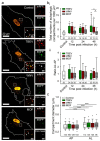Astrocytes Are a Key Target for Neurotropic Viral Infection
- PMID: 37759529
- PMCID: PMC10528686
- DOI: 10.3390/cells12182307
Astrocytes Are a Key Target for Neurotropic Viral Infection
Abstract
Astrocytes are increasingly recognized as important viral host cells in the central nervous system. These cells can produce relatively high quantities of new virions. In part, this can be attributed to the characteristics of astrocyte metabolism and its abundant and dynamic cytoskeleton network. Astrocytes are anatomically localized adjacent to interfaces between blood capillaries and brain parenchyma and between blood capillaries and brain ventricles. Moreover, astrocytes exhibit a larger membrane interface with the extracellular space than neurons. These properties, together with the expression of various and numerous viral entry receptors, a relatively high rate of endocytosis, and morphological plasticity of intracellular organelles, render astrocytes important target cells in neurotropic infections. In this review, we describe factors that mediate the high susceptibility of astrocytes to viral infection and replication, including the anatomic localization of astrocytes, morphology, expression of viral entry receptors, and various forms of autophagy.
Keywords: astrocytes; autophagy; cell metabolism; endosome; lysosome; oxidant species; viruses.
Conflict of interest statement
The funding sponsors had no role in the design of the study; in the collection, analyses, or interpretation of data; in the writing of the manuscript, and in the decision to publish the results.
Figures



Similar articles
-
In human astrocytes neurotropic flaviviruses increase autophagy, yet their replication is autophagy-independent.Cell Mol Life Sci. 2022 Oct 25;79(11):566. doi: 10.1007/s00018-022-04578-7. Cell Mol Life Sci. 2022. PMID: 36283999 Free PMC article.
-
SARS-CoV-2 Infection of Human Neurons Is TMPRSS2 Independent, Requires Endosomal Cell Entry, and Can Be Blocked by Inhibitors of Host Phosphoinositol-5 Kinase.J Virol. 2023 Apr 27;97(4):e0014423. doi: 10.1128/jvi.00144-23. Epub 2023 Apr 11. J Virol. 2023. PMID: 37039676 Free PMC article.
-
Cytosolic DNA Sensors and CNS Responses to Viral Pathogens.Front Cell Infect Microbiol. 2020 Sep 16;10:576263. doi: 10.3389/fcimb.2020.576263. eCollection 2020. Front Cell Infect Microbiol. 2020. PMID: 33042875 Free PMC article. Review.
-
Astrocyte infection by HIV-1: mechanisms of restricted virus replication, and role in the pathogenesis of HIV-1-associated dementia.Curr HIV Res. 2003 Oct;1(4):463-73. doi: 10.2174/1570162033485122. Curr HIV Res. 2003. PMID: 15049431 Review.
-
Fast type I interferon response protects astrocytes from flavivirus infection and virus-induced cytopathic effects.J Neuroinflammation. 2016 Oct 24;13(1):277. doi: 10.1186/s12974-016-0748-7. J Neuroinflammation. 2016. PMID: 27776548 Free PMC article.
Cited by
-
Unraveling the SARS-CoV-2 spike protein long-term effect on neuro-PASC.Front Cell Neurosci. 2024 Dec 18;18:1481963. doi: 10.3389/fncel.2024.1481963. eCollection 2024. Front Cell Neurosci. 2024. PMID: 39744674 Free PMC article.
-
Plasma of COVID-19 Patients Does Not Alter Electrical Resistance of Human Endothelial Blood-Brain Barrier In Vitro.Function (Oxf). 2024 Jan 9;5(2):zqae002. doi: 10.1093/function/zqae002. eCollection 2024. Function (Oxf). 2024. PMID: 38486975 Free PMC article.
-
New perspectives on heterogeneity in astrocyte reactivity in neuroinflammation.Brain Behav Immun Health. 2025 Jan 31;44:100948. doi: 10.1016/j.bbih.2025.100948. eCollection 2025 Mar. Brain Behav Immun Health. 2025. PMID: 40028234 Free PMC article.
-
Neuroinvasive and neurovirulent potential of SARS-CoV-2 in the acute and post-acute phase of intranasally inoculated ferrets.PLoS One. 2025 Apr 7;20(4):e0311449. doi: 10.1371/journal.pone.0311449. eCollection 2025. PLoS One. 2025. PMID: 40193353 Free PMC article.
-
The Role of Astrocytes in CNS Disorders: Historic and Contemporary Views.Cells. 2024 Aug 20;13(16):1388. doi: 10.3390/cells13161388. Cells. 2024. PMID: 39195276 Free PMC article.
References
-
- Ludlow M., Kortekaas J., Herden C., Hoffmann B., Tappe D., Trebst C., Griffin D.E., Brindle H.E., Solomon T., Brown A.S., et al. Neurotropic virus infections as the cause of immediate and delayed neuropathology. Acta Neuropathol. 2016;131:159–184. doi: 10.1007/s00401-015-1511-3. - DOI - PMC - PubMed
Publication types
Grants and funding
LinkOut - more resources
Full Text Sources

